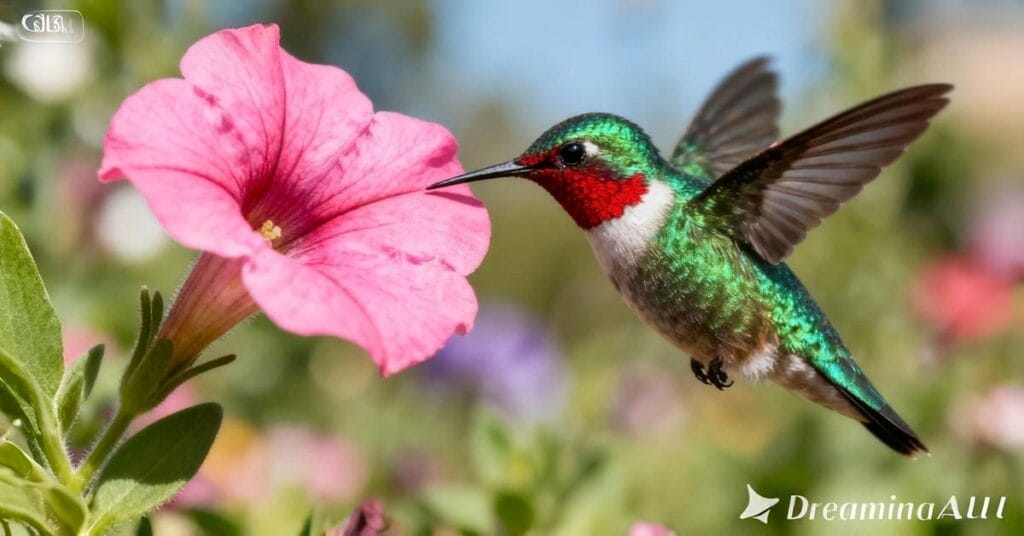The Magical World of Hummingbirds
Hummingbirds are among nature’s most extraordinary wonders. These tiny birds capture the hearts of bird lovers worldwide with their vibrant colors, incredible speed, and delicate beauty. Known for their dazzling iridescent feathers, they shimmer like flying jewels as they dart from flower to flower. Despite their small size, hummingbirds symbolize energy, joy, and resilience, inspiring countless artists and nature enthusiasts.
Their presence in flower gardens adds both beauty and ecological value, making them a beloved part of the natural world. In this article, we’ll explore everything about these fascinating creatures—from their habits to their importance in wildlife conservation.
Unique Characteristics of Hummingbirds
Unlike other bird species, hummingbirds are famous for their rapid wing speed—they can flap up to 80 times per second. This incredible movement produces the distinctive humming sound that gives them their name. With their specialized wings and lightweight bodies, hummingbirds can hover in mid-air and even fly backward, a feat unmatched in the avian world.
Their bright iridescent feathers change color depending on the angle of the light, creating a stunning effect that has long amazed scientists and photographers. These exotic birds often become the highlight of nature photography, capturing attention with every shimmer and motion.
Diet and Feeding Habits
Hummingbirds primarily feed on flower nectar, which provides the high energy needed to support their fast metabolism. They also consume tiny insects and spiders for protein. To sustain themselves, they visit hundreds of flowers daily, acting as natural agents of pollination.
Adding bird feeders filled with sugar water can attract hummingbirds to your backyard birds collection. However, it’s crucial to use the correct ratio—typically one part sugar to four parts water—and avoid red dye, which can harm the birds. Their feeding activity makes them essential contributors to the ecosystem balance, helping plants reproduce and thrive.
Migration and Adaptation
One of the most impressive aspects of hummingbirds is their long-distance bird migration. Some species travel thousands of miles between North and South America each year. Despite their tiny size, their stamina and determination are unmatched.
During migration, these tropical birds cross the Gulf of Mexico in a single flight, covering nearly 500 miles without stopping. Scientists have long studied these patterns of flying patterns to understand how such small creatures can endure extreme conditions.
Their ability to adapt to various climates—from the rainforests to mountain ranges—demonstrates their evolutionary strength. This resilience is one reason why hummingbirds have survived for millions of years.
The Role of Hummingbirds in Nature
Hummingbirds play a vital role in maintaining ecosystem balance. By feeding on nectar, they transfer pollen between flowers, assisting in pollination. Many tropical plants rely exclusively on these birds for reproduction. Their relationship with plants showcases a perfect example of mutual benefit—flowers provide nourishment, while hummingbirds ensure plant survival.
Moreover, they serve as indicators of environmental health. A decline in their population often signals problems in local habitats or climate conditions. That’s why wildlife conservation programs worldwide prioritize protecting these fragile creatures and their habitats.
Hummingbirds in Your Garden
Creating a haven for hummingbirds is both rewarding and environmentally beneficial. To attract them, plant brightly colored flowers such as trumpet vines, salvia, and bee balm. Providing bird feeders with fresh nectar will help sustain them, especially during migration.
Avoid pesticides, as they can harm not only insects but also these delicate nectar feeders. Adding water features like small fountains can also make your flower gardens more appealing to them.
If you enjoy birdwatching, your backyard can become a peaceful retreat full of movement, color, and melody. Observing their aerial acrobatics is a soothing experience for anyone who loves nature.
Fascinating Facts About Hummingbirds
- There are over 360 known bird species of hummingbirds worldwide.
- They can beat their wings up to 80 times per second and have a fast metabolism to support their energy needs.
- Despite their size, some species travel over 3,000 miles during bird migration.
- They remember every flower they visit, showcasing incredible spatial memory.
- Their aerial acrobatics are so precise that modern drones are designed based on their flying mechanisms.
Conservation and Global Importance
Hummingbirds face numerous threats, including habitat loss, climate change, and pesticide use. Conservation efforts are crucial to ensure their survival. Supporting organizations focused on wildlife conservation and planting native flowers can make a huge difference.
The decline of hummingbirds would not only affect pollination but also disrupt the natural ecosystem balance. Governments and environmentalists are collaborating to protect migration routes and nesting areas.
If you’re interested in learning about more amazing birds, read our detailed post on “The Colorful World of Parrots” for more insight into exotic avian life.
The Symbolism of Hummingbirds
In many cultures, hummingbirds symbolize joy, hope, and endurance. Their tireless movement reminds us to enjoy life’s sweetness and stay resilient through challenges. In Native American legends, they are seen as messengers of love and light, while in modern symbolism, they represent positivity and renewal.
Their vibrant colors and constant motion inspire artists, poets, and spiritual thinkers alike, making them more than just tiny birds—they are symbols of life’s fleeting yet beautiful nature.
Final Thoughts
Hummingbirds are not only breathtaking to watch but are also essential to the environment. Their role in pollination, their beauty, and their impressive endurance make them one of the most extraordinary bird species on Earth.
Welcoming them into your garden or supporting wildlife conservation efforts can help preserve these incredible creatures for future generations. So, the next time you hear a faint humming sound, look up—it might just be one of nature’s most dazzling jewels in flight.

